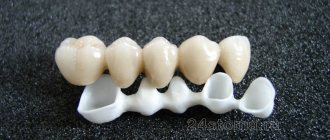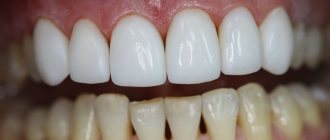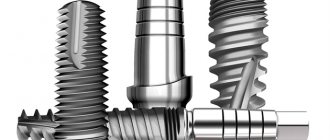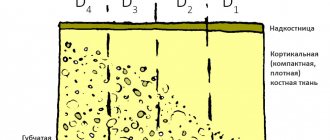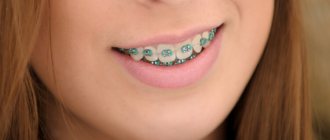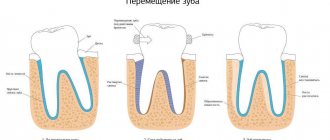Zirconium dioxide
There is probably not a single person who has not heard about zirconium dental crowns. They are talked about whenever we talk about restoring a missing tooth. Every dentist will offer you to put zirconium on your tooth.
Let's look at what it is, a zirconium crown, is it as good as they say about it, and what is the difference between zircon, zirconium, oxide and zirconium dioxide.
Zircon is the main mineral source of zirconium. Transparent zircon crystals are used in jewelry (hyacinth, starlite, jargon).
Quite often, when selling jewelry, the word “zircon” is mistakenly used to refer to a synthetic material with a strong shine - cubic zirconium dioxide (cubic zirconia).
Cubic zirconia was named in honor of the Physical Institute of the USSR Academy of Sciences (FIAN), where it was first synthesized, but the name is practically not used outside the former USSR and Eastern Europe. Abroad, this material is more often called zirconite. In some cases, especially in translations from foreign languages, cubic zirconia is called zirconium or zircon, which creates confusion, since cubic zirconia is a synthetic material imitating diamond, zircon is an unrelated yellow-brown mineral, and zirconium is a chemical element.
chemical element - shiny metal of silver-gray color.
Metal zirconium and its alloys have been used since the 30s of the 20th century in nuclear energy, in the alloying of metals, in pyrotechnics, and medicine.
In dentistry, zirconium dioxide stabilized with yttrium oxide is used. Composition: Zirconium dioxide ZrO2 95% Aluminum oxide Al2O3 <0.4% Yttria oxide Y2O3 5%
Vickers hardness up to 1250 HV 10 Compressive strength 2062 MPa Flexural strength 1554 MPa Elastic modulus 2500 MPa - 3700 MPa Density >6.06 g/cm3 Fracture toughness 7-10 MPa m1/2 (aluminum oxide 4.5 m1/2 ) CTE(25-500°C) 10•10-6 /K-1.
Pre-sintered zirconia, stabilized with yttria, is produced in the form of blanks intended for machine processing. Such zirconium is quite soft and allows for mechanical processing of workpieces to obtain products of complex shapes, followed by final sintering.
zirconium dioxide blanks
After final sintering, zirconium dioxide acquires maximum strength and stability.
Currently, there are several options for using zirconium dioxide to make dental crowns:
The first is that the frame of the future crown is machined from zirconium dioxide, similar to how the frame of metal-ceramic metal crowns is made. Next, the zirconium frame is veneered with ceramic masses to obtain the desired shape and color of the crown.
The second is that a crown is machined from zirconium into the complete anatomy, i.e. The tooth is entirely zirconium. Color effects are obtained by painting the frame with special dyes before the stage of final sintering (sintering). At this stage, the zirconium looks completely different from the tooth. However, after baking, the “multi-color” disappears and the teeth look natural.
Third , zirconium blanks are used with pre-painted layers of color and transparency for a more aesthetic appearance of all-zirconia crowns.
In practice, a frame made of zirconium dioxide with a thickness of 0.5-0.6 mm is capable of camouflaging not only the discolored teeth, but even metal stump inlays without the latter affecting the color of the finished structure. Naturally, the depth of subgingival preparation also matters. The use of fluorescent shoulder mass, as well as fludentins, brings zirconium dioxide closer to the identity of natural teeth in terms of light transmission. In any case, this indicator will be no worse than that of press ceramics.
When a crack appears in the material, a phase transition from the tetragonal modification to the monoclinic modification is initiated at its tip. The transition of the tetragonal phase of zirconium dioxide to the monoclinic phase is accompanied by an increase in volume and, as a consequence, local increases in volume and, accordingly, pressure, which stabilizes the microcrack, slowing down its growth. This “stress-strain” process usually occurs only in steel alloys. Therefore, zirconium dioxide stabilized with yttria oxide is also called “ceramic steel”.
- BIOCOMPATIBILITY and INERTIBILITY . The use of zirconium dioxide eliminates any allergic reactions from the body. In addition, it is compatible with all materials used in dentistry and cannot cause galvanism if you already have metal structures in your mouth.
- Not subject to CORROSION and OXIDATION . Therefore, it does not change the color of the tissues surrounding the crown (as is the case with metal ceramics).
- Zirconium dioxide crowns are THINner and LIGHTER than metal ceramics. This allows for less grinding of the supporting teeth and therefore they are less injured and last longer.
- ADAPTATION to such crowns occurs faster .
- Since zirconium dioxide has low THERMAL CONDUCTIVITY , living teeth under crowns are less sensitive to sudden temperature changes.
- The ideal PRECISION with which the zirconium crown adheres to the support is ensured by modern digital technologies. Zirconium is turned on digitally controlled machines (CAD/CAM), eliminating the human factor. The photo below shows a milling machine for processing zirconium dioxide.
- The AESTHETICS of orthopedic structures using zirconium dioxide increases significantly, since zirconium is a light and light-permeable material, which allows you to create orthopedic restorations indistinguishable from your own tooth tissues. The aesthetics naturally last longer.
The photo below compares the color transmission of crowns with a frame made of zirconium dioxide and metal ceramics. The result is obvious!
The photographs below show the replacement of old restorations on teeth 1.1. and 2.1 for crowns with a zirconium dioxide framework. Notice how vibrant the restorations are.
- It is possible to make individual abutments from zirconium dioxide for implant prosthetics. In this case, ideal conditions are created to maintain the health of the gums around the implant. According to some scientific data, gum tissue grows to the surface of zirconium, creating a bond similar to the bond of soft tissue in a natural tooth.
As for the disadvantages of zirconium dioxide, we can probably highlight only one - cost. Yes, the cost of a crown with a zirconium dioxide frame is approximately 20% higher than a metal-ceramic crown. However, against the backdrop of all the advantages that metal ceramics do not have, zirconium dioxide is the absolute winner!
See the works I have completed in the MY WORKS section.
Price
The main suppliers of zirconium to the world market are Australia and South Africa.
Recently, the preponderance in the export of zircon and zirconium minerals has increasingly leaned towards the Republic of South Africa. The main consumers are the European Union (Italy, France, Germany), China and Japan. Zircon is traded mainly in the form of ferroalloys. Over the past 10 years, demand for zirconium metal has increased by an average of 5.2% per year. During this time, production capacity managed to rise by a little more than 2%. As a result, there was a constant shortage of zirconium on the world market, which was a prerequisite for increasing its cost.
There are 2 main reasons for the growth in demand for this metal:
- Global expansion of the nuclear industry.
- Active use of zirconium in the production of ceramics.
Also, some experts believe that the increase in zirconium prices was partly influenced by the cessation of baddeleyite mining in Australia.
On the Russian secondary metal market, the cost of zirconium ranges from 450 to 7,500 rubles per kilogram. The purer the metal, the more expensive the price.
Application
The above properties provide zirconium with extensive use in various industries. The following areas are highlighted here:
- In electrical engineering, zirconium alloy with niobium is used as a superconductor. Withstands loads up to 100 kA/cm2. The transition point to the superconducting mode is 4.2 K. Also in radio equipment, electronic circuit boards are coated with zirconium to absorb the released gases. Zirconium filters for X-ray tube radiation are characterized by a high monochrome value.
- In nuclear energy, it is used as a material for the shells of fuel rods (the zone where nuclear fission and heat energy production are directly carried out) and other components of a thermonuclear reactor.
- Metallurgy uses zirconium as an alloying element. This metal is a strong deoxidizer, surpassing both manganese and silicon in this indicator. Adding only 0.5% zirconium to structural metals (steel 45, 30KhGSA) increases their strength by 1.5-1.8 times. In this case, the cutting process is further improved. Zircon is the main component of corundum ceramics. Compared to fireclay, its service life is 3-4 times longer. This refractory material is used in the manufacture of crucibles and troughs of steel furnaces.
- In mechanical engineering, metal serves as a material for products such as pumps and pipe shut-off valves that operate under conditions of exposure to aggressive environments.
- In pyrotechnics, zirconium metals are used to make fireworks and fireworks. This happens due to the absence of smoke during combustion, as well as the release of a significant amount of light energy.
- In the chemical industry, zircon serves as a raw material for cermet - a metal-ceramic coating with increased wear resistance and immunity to acids.
- In optics, cubic zirconia is actively used - processed zircon with additions of scandium and other rare earth metals. Cubic zirconias have a significant refractive angle, which allows them to be used as a material for the production of lenses. In jewelry, cubic zirconia is known as a synthetic substitute for diamond.
- In the military industry, zirconium is used as a filler for tracer bullets and flares.
Fixation methods
To attach the prosthetic structure to the implant, special elements called an abutment are used. They are usually supplied complete with implants with which they are supposed to be installed.
But they can also be made individually in the clinic’s laboratory. This is advisable if there is some clinical feature that makes the use of a standard or branded product undesirable.
Abutments have different designs. In most cases, their shape resembles a truncated cone; in other cases, they look like a sphere or other figure.
Abutments can be made integral with the implant. In other cases, they are connected to it using a threaded connection, for which they have a thread in the upper part for attaching the crown. The connection between the crown and the abutment can be permanent (using cement) or detachable (screwed).
The advantages of permanent connections include the technological simplicity of fastening, as well as the absence of the need for precise execution of the abutment, especially if it serves as a support in a bridge. And the cost of an abutment without fastening accessories is less.
The disadvantage of cement fastening is the inability to disassemble the superstructure if repair of any of its elements is required. The advantage is that there is no requirement for increased accuracy, since cement is able to compensate for some manufacturing inaccuracy.
In contrast to a permanent connection, a threaded fastening allows you to easily disassemble the structure and repair or replace a failed element.
The connection to the abutment is made outside the oral cavity. To insert a fixing screw through the crown into the abutment, a hole is made in it, which is sealed after installing the screw.
If for any reason it becomes necessary to detach the crown from the abutment, the seal covering the fastener is drilled out to access the screw.
The ability to disassemble is the most significant advantage of collapsible structures. Their disadvantages include increased complexity, the need for precise execution and a relatively high price.
The trend is that cement fixation is being used less and less. Dentists prefer screw fastening as it is more technologically advanced and advanced.
In the video, the doctor will talk in more detail about the methods of fixing crowns to an implant.
What are the advantages and disadvantages of zirconium crowns?
Zirconium crowns are used to restore almost completely destroyed, severely damaged teeth. Zirconium dioxide caps are recommended to be placed after root canal treatment, as well as during implantation (for installation on pins).
The main advantages of zirconium crowns:
- wear resistance;
- strength;
- durability;
- the ability to select shade and structure;
- biocompatibility;
- hypoallergenic.
But orthopedic structures made of zirconium dioxide have some disadvantages
The first thing you need to pay attention to is the type of finished products. For example, ceramic crowns are translucent
This allows you to make the shade of the artificial material similar to natural enamel.
Modern clinics use CAD/CAM technologies to produce zirconium crowns
Zirconium oxide is not as transparent as porcelain, so some patients are not very happy with the results. Also, zirconium microprostheses can cause destruction of the natural enamel of surrounding teeth. True, it may take many years for real wear to develop.
Aesthetics plus durability
White steel is what zirconium oxide ceramics are sometimes called. Crowns made from this material are 5 times stronger than all-ceramic dentures. What is the advantage of such strength? Before the advent of zirconium oxide in dentistry, crowns were made using a metal frame on which a thick layer of ceramic was applied. Metal for durability, ceramics for aesthetics. But it is impossible to create a completely natural look in this way; a dark strip is clearly visible at the place where the prosthesis comes into contact with the gum (this effect is achieved by a metal frame).
Zirconium oxide is not inferior in strength to metal, and allows you to convey the natural color and transparency, like that of a natural tooth, without any unnecessary color inclusions. It is similar in nature to tooth tissue and has light transmittance. Rays of light penetrating into the thickness of the crown are refracted and scattered naturally, creating the effect of a healthy and beautiful smile. When installing a prosthesis, dentists select a color that does not differ from the color of other healthy teeth, so the crown does not show itself in any way, merging with the healthy teeth.
general description
Unusual properties are what primarily determine the industrial value of such a relatively rare metal as zirconium. Its production is beneficial for the national economy due to:
High degree of chemical resistance.
Hydrochloric acid has absolutely no effect on this metal, and it reacts with sulfuric acid only when its concentration is at least 50% and at a temperature above +100 degrees.
Ability to burn in air with virtually no smoke.
Zirconium (finely dispersed) can spontaneously ignite at a temperature of 250 C.
Biological inertia.
Zirconium has absolutely no harmful effects on the human or animal body. Unfortunately, contrary to popular belief, it cannot bring any benefit either.
Not only this metal itself, but also its compounds are in great demand in industry. The mineral zircon, for example, is characterized by very high hardness and a pleasant diamond luster. Therefore, it is sometimes used as a cheap substitute for diamonds. However, recently zircon has been used less and less in jewelry. Nowadays, imitation diamonds are often made from cubic zirconia (artificial zirconium dioxide).
Being in nature
Zirconium occurs naturally only in the form of oxides and silicates. Among them, zircon, eudialyte, and baddeleyite are mainly distinguished. It is worth noting that the metal in deposits is always accompanied by hafnium. This happens due to the similar crystal lattice of metals.
The main share of zirconium minerals is located in the lithosphere. There is an average of 210 grams of zircon per ton of the earth's crust. Zirconium compounds are also found in seawater. But its concentration here is much lower and amounts to 0.05 mg per 1000 liters.
The leaders in the number of zirconium deposits are Australia (zircon), South Africa (baddeleyite), slightly less than the USA, Brazil and India. Russia accounts for 10% of world reserves.
Features of metal-ceramic crowns
The material includes a combination of metal (alloy or one type) and ceramics. Externally, crowns are very similar to natural teeth, which allows them to be used for prosthetics of anterior incisors and chewing molars.
The base is a metal frame (thickness 0.3-0.5 mm). The coating on the outside is made of ceramic (thickness 1-1.5 mm).
The following types of metals are used in the frame manufacturing process:
- cobalt;
- chromium;
- nickel;
- gold;
- platinum, etc.
Products made of metal ceramics have the following advantageous characteristics:
Metal-ceramic crowns - cases of allergies are rare, only in those patients who react to metal-aesthetic indicators, which make it possible to use crowns for prosthetics of the anterior incisors;
a modern palette of shades allows you to choose a tone that matches the natural color of your teeth (the dentition will not have accents); strength of the material (metal-ceramics can withstand chewing loads); cases of allergies are rare, only in those patients who react to metal; if a fragment breaks off due to careless handling of teeth, the defect can be restored; the color of the product does not change throughout the entire period of use of the tooth; resistance to displacement is noted; care does not require high costs and complex procedures; long wearing period (up to 15 years); affordable price.
Metal-ceramics also have disadvantages; they must be taken into account when choosing a material for a crown. A significant disadvantage is the need to grind the tooth during installation of the structure.
A layer of about two millimeters is removed from the bone tissue, which is quite a lot. In addition, in many cases, a depulpation procedure is performed.
Among other things, experts highlight other disadvantages:
- the material does not transmit light, so the outline of a metal frame is sometimes visible on the surface of the crown;
- at the border with the gum, cyanosis of the soft tissues sometimes forms due to the pressure of the prosthesis;
- Over time, the frame may become exposed, which will lead to the development of caries or other dental diseases.
The installation of metal-ceramic crowns is recommended by experts:
- when most of the bone tissue of the tooth is destroyed (more than 50%);
- if one or more teeth are lost;
- with the loss of a fragment of bone tissue due to progressive caries;
- in order to eliminate aesthetic and functional problems in the dentition;
- for installation of prostheses and during implantation (fitting on a pin).
Experts have identified limitations regarding the installation of metal-ceramic crowns:
- diseases of the central nervous system;
- the presence of chronic periodontal pathologies;
- malocclusion;
- presence of infectious diseases or rehabilitation period;
- exacerbation of diseases of the oral mucosa;
- involuntary grinding of teeth;
- pregnancy period.
A clear limitation to the use of metal ceramics is an allergy to metal.
Metal-ceramic crown on a front tooth
Advantages of zirconium crowns over metal-ceramics
If prosthetics are necessary, the patient is faced with the question of which artificial teeth to choose. Zirconium oxide has many advantages over other materials:
- Prosthetics with zirconium crowns do not require nerve removal.
- Lack of metal in the design, which eliminates problems such as allergic reactions and metallic taste in the mouth.
- Guaranteed absence of disease development under the crown. The denture fits tightly to the gum, food particles and bacteria do not get under it.
- Accuracy of frame execution. Digital data processing guarantees incredible precision in the manufacturing of the structure.
- Individual color selection. The finished prosthesis cannot be visually distinguished from other healthy teeth.
- Possibility of manufacturing a bridge of any length;
- Lightness of design.
- Lack of reaction to cold and hot food. Wearing metal ceramics may cause discomfort due to high or low temperatures. Zirconium oxide does not give such a reaction.
- Absolutely natural appearance.
- Absence of a gray border in the area of contact with the gum.
- When preparing for prosthetics, there is no need to heavily grind the tooth.
- Crowns do not deform and retain their appearance and shape for a long time.
Zirconium in its elemental form is a silvery-white metal with characteristic properties such as corrosion resistance and ductility. In nature it is quite common, but at the same time very scattered. Large deposits of it have not yet been found. People first learned about the possibility of the existence of this metal in 1789. Then the chemist M. Klaproth, while studying the mineral zircon, accidentally discovered its oxide. This metal was obtained in its pure form only in 1925. In the modern world, zirconium, the production of which is widespread, is used in a wide variety of industries. Of course, many domestic enterprises are also producing it.

